The DNA makeup of Todd Reed must be a most fascinating study. His background should indicate anything but a life as an artist in pursuit of heady investigations that straddle art and science. The cool polished artworks Reed produces utilise analytical and formal strategies that are more often realized in urban studios filled with stacks of art history and theory tomes. This week the COMP Magazine caught up with Reed in Joliet, Illinois, to discuss his youth downstate in a small town, his fascination with optics and memory recall, the use of materials and methods commonly used in industrial fabrication, and the intersection of his role as an educator and studio practice.
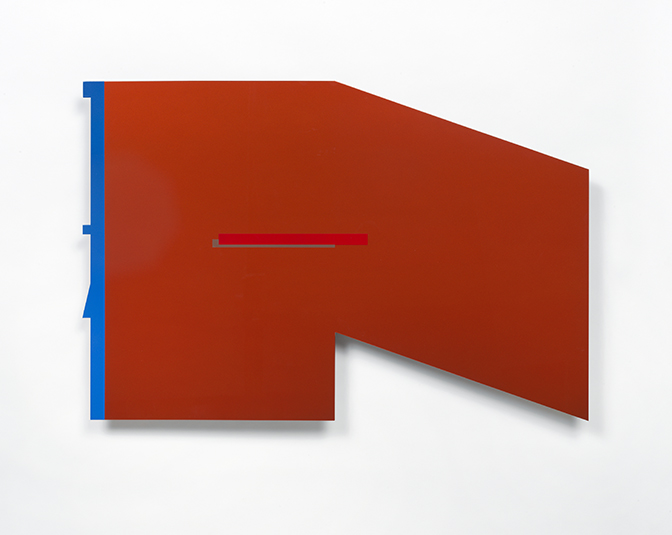
You are from down state, grew up in a fairly small community, studied at Eastern Illinois University and Illinois State University. I’m curious what role the visual arts played in your youth. Was there a specific experience or person that set you off on your aesthetic exploration?
In hindsight it is very surprising that I ended up an artist! Honestly, visual art was never a significant part of my upbringing downstate. I was completely unaware of contemporary art growing up. During my youth, the only serious exposure that I had to anything related to the visual arts would have been taken in through movies and television. This likely only added to my misunderstanding of what artists did. I sort of knew that Modernism happened. But, I really didn’t understand enough about world history, or anything else for that matter to put the pieces together or to choose a direction as an artist. Really, the extent of my understanding of art was based on myths about talent and how either you have it, or you don’t. My hometown was simply not a cultural hub, and I was a product of my environment.
I probably didn’t realize how out of touch I was until I arrived at Eastern Illinois University in 1997. I suddenly found myself surrounded by people who were from bigger towns or the suburbs of Chicago. These people had been through serious AP art classes in high school. Conversely, my early art education consisted of things like learning oil painting by being shown a Bob Ross video. Nothing against Bob Ross. But, just sayin….I really had a lot of catching up to do. I began to realize that I was way out of my league, and that I could learn a lot from my new peers and professors. This bit of self-awareness was really the beginning of my creative trajectory.
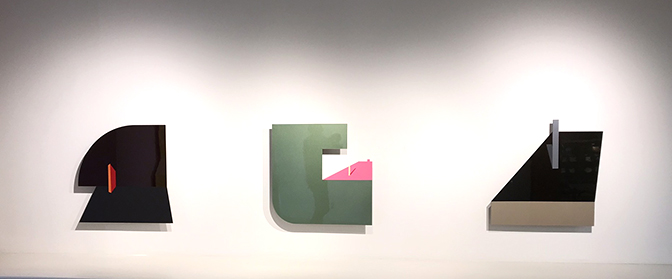
Bloomington, Minnesota, 2019
You have been creating highly polished reductive works for over a decade now. In some ways I see silhouettes of partly recognized forms (like a house or sidewalk), yet often I see these works as pure examinations of formal studies using fields of color that contrast shapes moving the viewer toward optical illusions. Can you discuss the intent of your practice? Where does the idea meet the applied fabrication?
Your general description of the work is perfect! I am trying to draw the viewer’s attention to the mechanics of perception. So, yes, the pieces are very formal, as you state. However, I am attempting to arrange shapes, colors/values, physical edges, and optical edges in ways that recall movement through certain types of spaces and places.
The language of abstraction that I employ is intended to come off as a reflection on the man-made world. Though my work is not solidly representational, I use a vocabulary of shapes that vaguely reference elements of designed spaces. The places and spaces that I am most interested in do have something in common. Yet, they can reference experiences as different as a stroll down the aisle of a supermarket or a 75 MPH drive on a busy tollway.
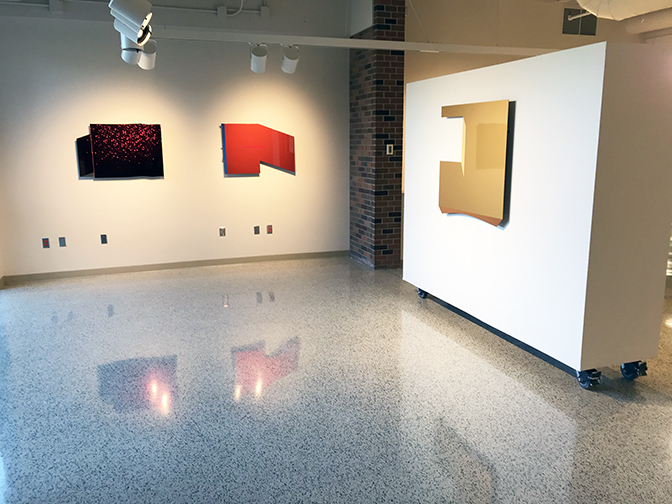
Bloomington, Minnesota, 2019
Can you walk us through your conceptual and tactile studio process?
The process for realizing one of my finished works can be broken down into 5 major steps. The steps in order include sketching, digital drawing in CAD, metal fabrication, monochrome and clear-coat by an auto-body painter, and finally my own painted marks.
The process starts with drawing on paper. The drawings are usually small thumbnails and doodles that are variations on certain themes. For instance, I have been making a lot of thumbnails lately that deal with the suggestion of folds and perspectival space. At other times, I am sketching compositions that might reference the profiles of architectural moldings or the façade of a building. It just depends on what I am in the mood for when I am sketching. Eventually, I sit down at the computer and get some of these drawings into CAD. When creating the digital drawings for fabrication, I am basing them on the ideas generated in the thumbnails. However, the ideas change slightly from paper to digital. I never feel restricted by what I have drawn on paper. Though my finished works are very pristine and polished, the idea is continually evolving until I have painted in the last shape. This is really no different than how any other painter or sculptor would materialize finished works from sketches. The creative energy keeps flowing throughout the process.

How do you organize your works? Into series? Chronologically? By idea? In part, I see a never-ending puzzle being produced where your early efforts made back in 2008 can easily be viewed with current work.
It’s great that you see such a strong connection between the earlier work and what I am doing now. It really is a never-ending puzzle as you describe it. The common thread within the puzzle deals with hard-edge shapes and color interactions that conjure up fuzzy memories of in-between moments like scrolling down your newsfeed within a social media app or whizzing down a boulevard in a car. The visual intake that we are tuning out in situations like these is actually the bulk of our reality. We are just really good at creating mental shortcuts around most of what we see in order to focus our cognitive energy on what gives us pleasure or keeps us alive.
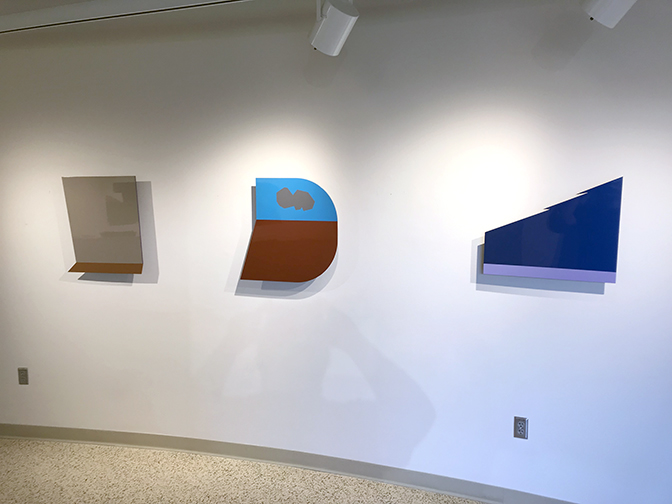
Bloomington, Minnesota, 2019
You are now teaching at USF in Joliet, Illinois, among a number of other area institutions. Do see any overlap with your teaching and studio inquiry? Are there any specific items or approaches that you regularly share with your students?
Oh, for sure. There are definitely overlaps between my teaching and what I am doing in my own studio work. I am always pushing the importance of drawing to my students. Observation-based drawing is a really great way to learn to be sensitive to visual phenomenon, and to learn composition.
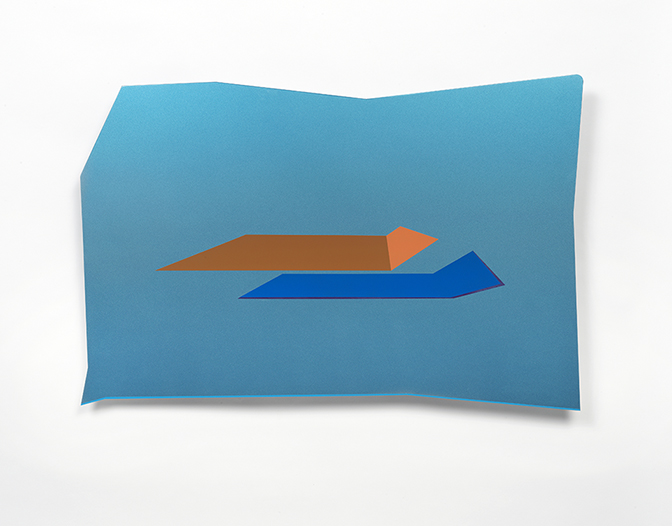
What’s up for the remainder of 2019? And, 2020? What are you currently working upon? Are there any exhibitions or projects in process?
I currently have a solo exhibition up at Normandale Fine Arts Gallery at Normandale Community College in Minneapolis, Minnesota. I am showing 6 new pieces that are being exhibited for the first time in this show, as well as 4 larger pieces that were completed between 2017-2018. I am looking forward to a productive 2020!
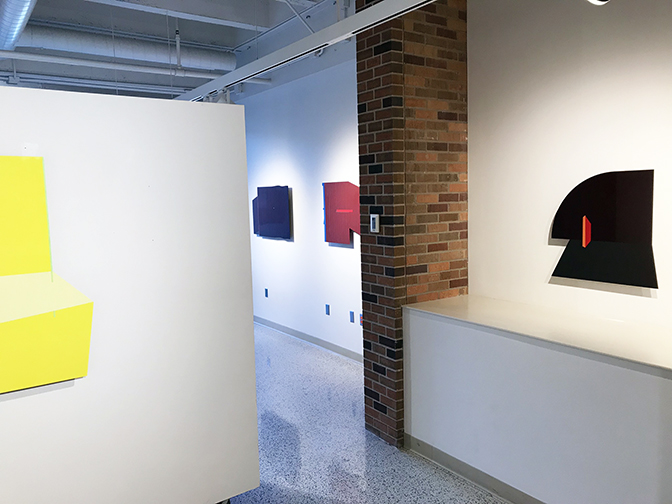
Bloomington, Minnesota, 2019
For additional information on the aesthetic practice of Todd Reed, please visit:
Todd Reed – https://toddreedpaints.com/home.html
Facebook – https://www.facebook.com/Normandale-Fine-Arts-Gallery-196264337353/?pageid=196264337353&ftentidentifier=10157728492947354&padding=0
The COMP Magazine – http://www.thecompmagazine.com/todd-reed-perimeters-and-other-experiences-of-edge/
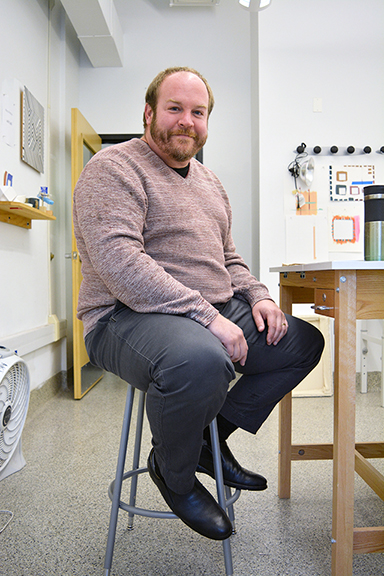
Artist interview and portrait by Chester Alamo-Costello


